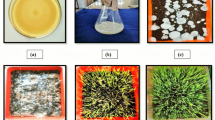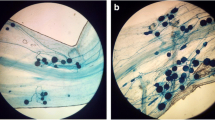Salinity is a major constraint to crop productivity worldwide. Piriformospora indica was shown to promote the growth and also enhance resistance/tolerance to biotic and abiotic stresses. This work was intended to study the potential of P. indica in enhancing growth and elevating salt resistance in barley (Hordeum vulgare L.). Physiological and morphological experiments were used to investigate the metabolome changes in inoculated plants. The seedlings were inoculated with P. indica and 2 weeks after inoculation were treated with three salt stress levels. Four weeks after inoculation, leaf samples were collected and metabolite was extracted from leaves of inoculated and noninoculated barley (cultivar Pallas) plants. The physiological results showed that P. indica increases the biomass of aerial parts of inoculated plants compared with control plants under ambient and stress condition. Also, fungus affected ion content in inoculated plants and increased the K+/Na+ and Ca2+/Na+ ratios. The metabolomic results revealed that P. indica increases the sugars and free amino acid content in inoculated plants compared with control plant under salt stress. According to the results, this fungus can be used to produce growth-stimulating agents and biological fertilizers for use in crop production.



Similar content being viewed by others
References
A. Varma, S. Verma, N. Sahay, B. Butehorn, and P. Franken, Appl. Environ. Microbiol., 65, 2741 (1999).
V. Rai, Biol. Plantarum, 45, 481 (2002).
M. Ghabooli, B. Khatabi, F. S. Ahmadi, M. Sepehri, M. Mirzaei, A. Amirkhani, J. V. Jorrin-Novo, and G. H. Salekdeh, J. Proteomics, 94, 289 (2013).
F. Waller, H. Achatz, H. Baltruschat, J. Fodor, M. Becker, M. Fischer, T. Heier, R. Huckelhoven, C. Neumann, and D. Von Wettstein, Proc. Natl. Acad. Sci. USA, 102, 13386 (2005).
X. Qiang, M. Weiss, K. H. Kogel, and P. Schafer, Mol. Plant Pathol., 13 (5), 508 (2012).
Y. Hu and U. Schmidhalter, J. Plant Nutr. Soil Sci., 168, 541 (2005).
J. Liu and J. K. Zhu, Proc. Nat. Acad. Sci. USA, 94, 14960 (1997).
H. Knight, J. Trewavas, and M. R. Knight, Plant J., 12, 1067 (1997).
J. Vadassery, S. Ranf, C. Drzewiecki, A. Mithofer, C. Mazars, D. Scheel, J. Lee, and R. Oelmuller, Plant J., 59, 193 (2009).
S. Mahajan and N. Tuteja, Arch. Biochem. Biophys., 444, 139 (2005).
I. Sherameti, B. Shahollari, Y. Venus, L. Altschmied, A. Varma, and R. Oelmuller, J. Biol. Chem., 280, 26241 (2005).
M. F. Thomashow, Annu. Rev. Plant Biol., 50, 571 (1999).
L. A. Wanner and O. Junttila, Plant Physiol., 120, 391 (1999).
S. Kaur, A. K. Gupta, and N. Kaur, Plant Growth Regul., 30, 61 (2000).
J. Price, A. Laxmi, S. Martin, and J. C. Jang, Plant Cell, 16, 2128 (2004).
L. Borras, G. A. Slafer, and M. E. Otegui, Field Crops Res., 86, 131 (2004).
H. J. Bohnert and R. G. Jensen, Trends Biotechnol., 14, 89 (1996).
S. Ramanjulu and D. Bartels, Plant, Cell Environ., 25, 141 (2002).
M. Mansour, Biol. Plantarum, 43, 491 (2000).
F. Fougere, D. Le Rudulier, and J. G. Streeter, Plant Physiol., 96, 1228 (1991).
T. Yamaya and H. Matsumoto, Berichte des Ohara Instituts fur Landwirtschaftliche Biologie, Okayama Universitat, 19, 181 (1989).
M. Ashraf and M. Tufail, J. Agron. Crop Sci., 174, 351 (1995).
M. Ashraf, Biol. Plantarum, 36, 255 (1994).
W. J. Hurkman, H. P. Tao, and C. K. Tanaka, Plant Physiol., 97, 366 (1991).
L. Simon-Sarkadi, G. Kocsy, and Z. Sebestyen, Acta Biol. Szeged., 46, 73 (2002).
E. Abraham, G. Rigo, G. Szekely, R. Nagy, C. Koncz, and L. Szabados, Plant Mol. Biol., 51, 363 (2003).
M. Mansour, Plant Physiol. Biochem., 36, 767 (1998).
N. Bouche and H. Fromm, Trends Plant Sci., 9, 110 (2004).
A. M. Kinnersley and F. J. Turano, Crit. Rev. Plant Sci., 19, 479 (2000).
G. H. Pham, R. Kumari, A. Singh, R. Malla, R. Prasad, M. Sachdev, M. Kaldorf, F. Buscot, R. Oelmuller, and R. Hampp, Plant Surface Microbiol., 593 (2004).
H. Rolletschek, M. R. Hajirezaei, U. Wobus, and H. Weber, Planta, 214, 954 (2002).
L. Voll, R. E. Hausler, R. Hecker, A. Weber, G. Weissenbock, G. Fiene, S. Waffenschmidt, and U. I. Flugge, Plant J., 36, 301 (2003).
M. R. Hajirezaei, Y. Takahata, R. N. Trethewey, L. Willmitzer, and U. Sonnewald, J. Exp. Bot., 51, 439 (2000).
V. B. Tognetti, M. D. Zurbriggen, E. N. Morandi, M. F. Fillat, E. M. Valle, M. R. Hajirezaei, and N. Carrillo, Proc. Nat. Acad. Sci., 104, 11495 (2007).
Author information
Authors and Affiliations
Corresponding author
Additional information
Published in Khimiya Prirodnykh Soedinenii, No. 6, November–December, 2014, pp. 942–946.
Rights and permissions
About this article
Cite this article
Ghabooli, M. Effect of Piriformospora indica Inoculation on some Physiological Traits of Barley (Hordeum vulgare) Under Salt Stress. Chem Nat Compd 50, 1082–1087 (2014). https://doi.org/10.1007/s10600-014-1164-9
Received:
Published:
Issue Date:
DOI: https://doi.org/10.1007/s10600-014-1164-9




